Types of Gem Cuts
TYPES OF GEM CUTS
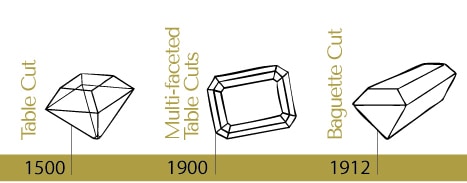
BAGUETTE CUT
A popular grinding, originated under the patronage of the famous French jewellery manufacturer ‘Cartier’, is the Baguette grinding. About 1920 this rectangular grinding originated in France. The term describes in the real sense of the word exactly its optical impression: rod or small rod. An exact rectangle with four 90° angles is sharpened from-out of the gemstone.
The processing of a stone using the Baguette grinding is difficult and needs the highest skills. The great danger for the cutter is that the gemstone splinters, because a considerable part of the material must be polished. If the perfect Baguette grinding succeeds, nevertheless, the visual overall impression of the antique piece of jewellery is harmonious and of flattering consistency.
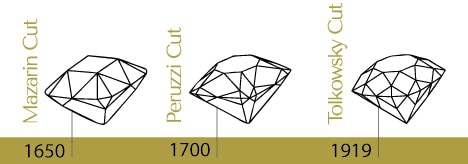
BRILLANT CUT
In 1910 came after years of research and optimization of the cut, what is considered the standard today: the brilliant cut. It is the result of feverish efforts of the stonecutter, (this term is another example of the standardization!) to increase the maximum brilliance of a diamond. The gloss and the glitter in the stone is the result of breaking the incident light.
The more and the more detailed the cuts are executed more impressive is the result. This is pure mathematics, and therefore the diamond- reference-cut is calculated very precisely and is for every jewellery manufacturer a mandatory requirement. The diamond is made from top to bottom as follows. The crown, which closes the top with a flat panel, forms the top. It follows the widest part of the diamond, the girdle. The pointed downwardly concludes with the pavilion. The scheme of the various facets is set. Overall a brilliant gets 58 facet cuts.
The scientific analysis of the optical effect and the colour play of brilliants resulted in the 1919 created ‘Tolkowsky-brilliant’. This reference is in the US today valid. In Germany there was a new calculation 1939 in ‘Praxis Eppler’, the so called ‘fine cut’. In Scandinavia on the other hand, they calculated 1969 the ‘Scandinavian Standard-Brilliant’. Nevertheless, it is still the Tolkowsky brilliant which is regarded as the standard today worldwide.
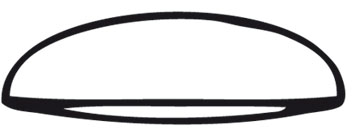
CABOCHON CUT
The worldwide used French term Cabochon stands for a smooth cut gemstone. The alternative terms ‘straight cut’ and ‘mugel cut’ are also common. Not only by the technology a cabochon cut stand apart from the facets cuts. Primarily for the viewer is the uniquely beautiful play of colour and the iridescence effects that stand out. Completely different light reflections are created as with facets.
Depending which gem got the smooth cut, different iridescent effects can be admired. For this, the crystal structure of the gemstone is responsible respectively. For example a blue white glow migrates over Moonstone, when you move the moonstone cabochon. This baffling phenomenon is called adularescence. That as the cat’s eye effect known phenomenon Chatoyance in turn, is the fascinating shimmer, a smooth cut sapphire or a tiger-eye produces.
Thus, the perfectly executed cabochon cut is in or on many antique jewellery pieces a real eye-catcher. It is not uncommon the most impressive way to put a jewel in scene. Because the colour stone, which can have an effect like this, develops its own unique sophistication through the refractions of light.

PAMPEL CUT
The pampel cut corresponds in its shaping to an elongated drop. Polished gemstones in that manner are suited especially well for pendants, necklaces and slope earrings. This unusual elaboration belongs to so-called ‘fancy’ cuts. It is not so omnipresent as the popular grindings and, hence, in antique jewellery always a special eye-catcher.
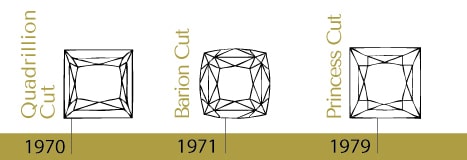
PRINCESS CUT
The Princess cut is the rectangular diamond form with most fire. Besides the brilliant cut, this still very young grinding belongs above all in the USA to the most popular variations. The Princess cut has originated in the 1960s and is known as the first square shaping for diamonds. Its facets make it weighs more carat than a round diamond with identical diameter, because of the angular form.
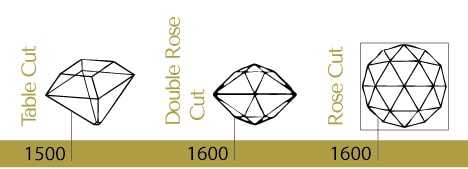
ROSE CUT
The rose cut was applied in the Dutch region since the late 16th century. He belongs to the so-called diamond cuts and is classified in the category of the old cuts. The diamonds get a flat bottom and to the top of the stone triangular cut facets. The thus obtained optical impression is similar to a rose petal. To increase the luminosity and the fire, rose cut diamonds were often placed on a reflective foil.
This method is very special and had its most common use in Antwerp, in the province Brabant and near the French border, in Charleroi. The rose cut is rarely cut today. In the heyday of this Dutch-Belgian cut emerged fantastic jewellery. Very popular is the ‘Antwerp Rose’.

EMERALD CUT
The emerald cut is so called because it was originally found mainly in emeralds application. It belongs to the so-called step cuts. This describes the visual perception absolutely aptly. There are elongated facets that are parallel and thus reminding of stairs. The cutter must carefully choose this cut, because it reveals even the smallest defects in the stones.
Stones of perfect purity though, unfold in the emerald cut a suggestive charm. The long facets look very elegant and are, when executed by a master, polished in the finest. The emerald cut is usually made of 57 facets. But this can also vary. First mention under its name emerald cut we find in Art déco. However, it is demonstrated, that this cut was already carried out earlier. However stylistic characteristics of this cut can be attributed up to the early panel cuts about 500 years ago.

DROP CUT
The drop grinding, from time to time also called tear grinding, unites two impressive grinding forms in one. The combination of the brilliant and marquise cut strengthens by their huge number of facets the fire in the stone. The elongated shape of the gemstone in the drop grinding flatters further the wearer and her hand, because it extends optically the fingers.
The drop grinding goes back in its development to the 15th century. There was a visionary grinder from Belgium, who has planned the implementation of the grinding, as well as he developed an appropriate polishing disc for diamonds with which the desired facets could be polished only then. This grinder, Lodewyk of Berken, is virtually the pioneer for all fine grindings of gemstones, because his self-developed polishing disc has brought light reflections to full potential.



